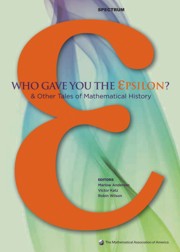Book contents
- Frontmatter
- Introduction
- Contents
- Analysis
- Geometry, Topology and Foundations
- Algebra and Number Theory
- Foreword
- Hamilton's Discovery of Quaternions
- Hamilton, Rodrigues, and the Quaternion Scandal
- Building an International Reputation: The Case of J. J. Sylvester (1814–1897)
- The Foundation Period in the History of Group Theory
- The Evolution of Group Theory: A Brief Survey
- The Search for Finite Simple Groups
- Genius and Biographers: The Fictionalization of Evariste Galois
- Hermann Grassmann and the Creation of Linear Algebra
- The Roots of Commutative Algebra in Algebraic Number Theory
- Eisenstein's Misunderstood Geometric Proof of the Quadratic Reciprocity Theorem
- Waring's Problem
- A History of the Prime Number Theorem
- A Hundred Years of Prime Numbers
- The Indian Mathematician Ramanujan
- Emmy Noether
- “ Marvelous Proof,”
- Afterword
- Surveys
- Index
- About the Editors
The Search for Finite Simple Groups
from Algebra and Number Theory
- Frontmatter
- Introduction
- Contents
- Analysis
- Geometry, Topology and Foundations
- Algebra and Number Theory
- Foreword
- Hamilton's Discovery of Quaternions
- Hamilton, Rodrigues, and the Quaternion Scandal
- Building an International Reputation: The Case of J. J. Sylvester (1814–1897)
- The Foundation Period in the History of Group Theory
- The Evolution of Group Theory: A Brief Survey
- The Search for Finite Simple Groups
- Genius and Biographers: The Fictionalization of Evariste Galois
- Hermann Grassmann and the Creation of Linear Algebra
- The Roots of Commutative Algebra in Algebraic Number Theory
- Eisenstein's Misunderstood Geometric Proof of the Quadratic Reciprocity Theorem
- Waring's Problem
- A History of the Prime Number Theorem
- A Hundred Years of Prime Numbers
- The Indian Mathematician Ramanujan
- Emmy Noether
- “ Marvelous Proof,”
- Afterword
- Surveys
- Index
- About the Editors
Summary
At present, simple group theory is themost active and glamorous area of research in the theory of groups and it seems certain that this will remain the case for many years to come. Roughly speaking, the central problem is to find some reasonable description of all finite simple groups. A number of expository papers [36], [42], [45], [47], [49], [79] and books [21], [46], [67] detailing progress on this problem have been written for professional group theorists, but very little has appeared which is accessible to undergraduates. (Only Goldschmidt's proof of the Brauer-Suzuki-Wall theorem [44] comes to mind.) This paper is intended as a historical account of the search for simple groups for readers who are not experts in the subject. It is the hope of the author that the paper may profitably be read by one who is conversant with the contents of Herstein's algebra book [55]. A complete discussion of all important contributions to simple group theory is beyond the scope of this paper.
What are simple groups and why are they important? ÉvaristeGalois (1811–1832) called a group simple if its only normal subgroups were the identity subgroup and the group itself. The abelian simple groups are the group of order 1 and the cyclic groups of prime order, while the non-abelian simple groups generally have very complicated structures. These groups are important because they play a role in group theory somewhat analogous to that which the primes play in number theory or the elements do in chemistry; that is, they serve as the “building blocks” for all groups.
- Type
- Chapter
- Information
- Who Gave You the Epsilon?And Other Tales of Mathematical History, pp. 254 - 270Publisher: Mathematical Association of AmericaPrint publication year: 2009

